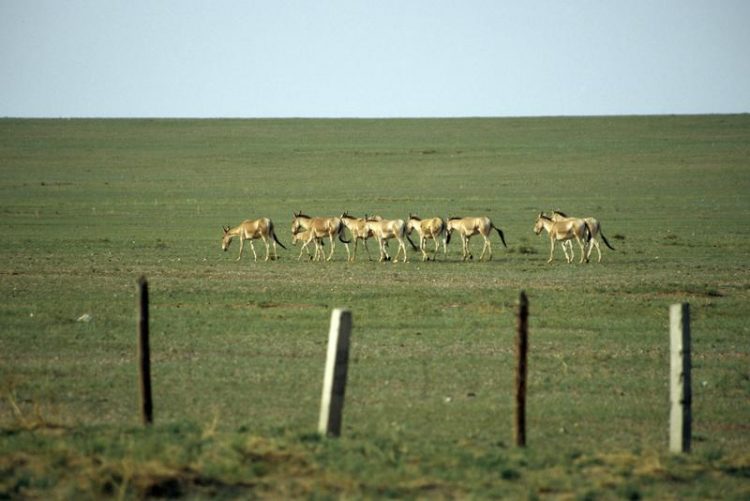Breaking down barriers – An appeal to conserve migratory ungulates in Mongolia´s grasslands

Mongolian wild ass are among the most mobile of terrestrial mammals, ranging over thousands of square kilometers each year. Photo: Petra Kaczensky / Vetmeduni Vienn
The scientists recommend reconciling the rapid infrastructure development that is currently taking place in Mongolia with the needs of migratory species, such as Asiatic wild ass and Mongolian gazelles. Their recommendations are published online in the journal Conservation Biology.
The Gobi-Steppe Ecosystem is world renowned for its populations of migratory ungulates, which cover great distances in search of forage. Researchers at the Research Institute of Wildlife Ecology at Vetmeduni Vienna have documented, that in just one year an individual wild ass can range over an area of 70,000 km2.
“Wild asses and gazelles have to be permanently on the move and travel very long distances to find enough food. Rainfall is highly variable in this region. As a consequence pastures are patchy and unpredictable in space and time,” explains Petra Kaczensky, one of the authors from the Vetmeduni Vienna.
Barriers to migration
Although vast stretches of land remain largely unaltered, migratory species face a number of obstacles that disrupt their journey and affect their ability to survive and reproduce in this highly variable environment. The main obstacles of the recent past are fences erected along the international borders with Russia and China and the Trans Mongolian Railroad.
The railroad fence now constitutes the de facto eastern border for the Asiatic wild ass, cutting the population off from its former much larger range to the east. Gazelles have also been largely restricted to either side of the railroad, but when they do attempt to cross they often get entangled or turned away. On its rapid path of economic development, Mongolia continues to build roads and new railway lines that are expected to threaten the ecological phenomenon of wildlife migration, if not carefully planned for.
Science can inform regional planning
Structural modifications could be made to fences, unnecessary fences could be removed in areas where there are no livestock, and planned railway lines could be re-routed to avoid sensitive areas. “We advocate a development process that minimizes negative effects on the integrity of the ecosystems such as following existing roads between villages to avoid large uninhabited regions while also incorporating the necessary designs so that they do not become new barriers; at the same time known barriers need to be removed,” says corresponding author Kirk Olson from Fauna & Flora International, a global conservation organization based in the UK. “Regional planners need to think big – meaning on the scale of the migrations,” adds author Nyamsuren Batsaikhaan from the National University of Mongolia.
A responsibility to link science and policy
Research into the movement and habitat requirements of the species roaming Mongolia´s Gobi-Steppe Ecosystem is ongoing, but needs to continue to identify potential conflicts between development efforts and biodiversity conservation requirements. Science can and should play a role in planning processes, according to Chris Walzer of the Vetmeduni Vienna, another author of the paper.
“It is also among the responsibilities of a university to provide that link between science and policy making. Scientists can provide constructive inputs in fields such as wildlife management and conservation,” Walzer emphasizes. “I think that if we do not translate our findings into practical advice that non-scientists can use, we have failed in our educational mission.” In the case of Mongolia, the authors are hopeful that joint efforts will lead to the preservation of the country´s outstanding natural heritage for future generations.
The article “Conserving the World’s Finest Grassland Amidst Ambitious National Development” by N. Batsaikhan et al. was recently published in the journal Conservation Biology. http://onlinelibrary.wiley.com/doi/10.1111/cobi.12297/abstract
About the University of Veterinary Medicine, Vienna
The University of Veterinary Medicine, Vienna in Austria is one of the leading academic and research institutions in the field of Veterinary Sciences in Europe. About 1,200 employees and 2,300 students work on the campus in the north of Vienna which also houses five university clinics and various research sites. Outside of Vienna the university operates Teaching and Research Farms. http://www.vetmeduni.ac.at
Scientific Contact:
Dr. Petra Kaczensky
Research Institute for Wildlife and Ecology
University of Veterinary Medicine Vienna (Vetmeduni Vienna)
M: +43 6767379650
petra.kaczensky@vetmeduni.ac.at
Released by:
Susanna Kautschitsch
Science Communication / Public Relations
University of Veterinary Medicine Vienna (Vetmeduni Vienna)
T +43 1 25077-1153
susanna.kautschitsch@vetmeduni.ac.at
http://www.vetmeduni.ac.at/en/infoservice/presseinformation/press-releases-2014/…
Media Contact
All latest news from the category: Ecology, The Environment and Conservation
This complex theme deals primarily with interactions between organisms and the environmental factors that impact them, but to a greater extent between individual inanimate environmental factors.
innovations-report offers informative reports and articles on topics such as climate protection, landscape conservation, ecological systems, wildlife and nature parks and ecosystem efficiency and balance.
Newest articles

Long-sought structure of powerful anticancer natural product
…solved by integrated approach. A collaborative effort by the research groups of Professor Haruhiko Fuwa from Chuo University and Professor Masashi Tsuda from Kochi University has culminated in the structure…

Making a difference: Efficient water harvesting from air possible
Copolymer solution uses water-loving differential to induce desorption at lower temperatures. Harvesting water from the air and decreasing humidity are crucial to realizing a more comfortable life for humanity. Water-adsorption…

In major materials breakthrough
UVA team solves a nearly 200-year-old challenge in polymers. UVA researchers defy materials science rules with molecules that release stored length to decouple stiffness and stretchability. Researchers at the University…



